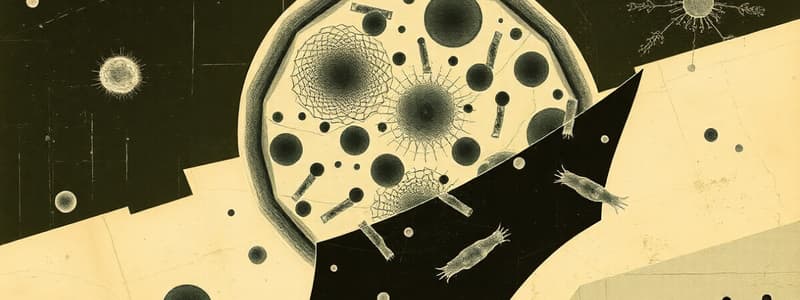Podcast
Questions and Answers
What distinguishes prokaryotic cells from eukaryotic cells regarding their nucleus?
What distinguishes prokaryotic cells from eukaryotic cells regarding their nucleus?
Prokaryotic cells lack a well-defined nucleus.
Name the smallest and largest types of cells.
Name the smallest and largest types of cells.
The smallest cell is Mycoplasma (0.3 μm) and the largest is an Ostrich egg.
What is the function of plasmids in prokaryotic cells?
What is the function of plasmids in prokaryotic cells?
Plasmids confer characteristics like antibiotic resistance and help in bacterial transformation with foreign DNA.
Describe the structure of the cell envelope in prokaryotic cells.
Describe the structure of the cell envelope in prokaryotic cells.
What are mesosomes and what role do they play in prokaryotic cells?
What are mesosomes and what role do they play in prokaryotic cells?
Differentiate between motile and non-motile prokaryotic cells.
Differentiate between motile and non-motile prokaryotic cells.
What are pili and fimbriae, and what are their functions?
What are pili and fimbriae, and what are their functions?
Explain the role and components of flagella in motile prokaryotic cells.
Explain the role and components of flagella in motile prokaryotic cells.
Flashcards are hidden until you start studying
Study Notes
Cell Theory
- All living organisms are composed of cells and cell products.
- All cells arise from pre-existing cells.
- Mycoplasma cells are the smallest known (0.3 μm).
- Ostrich eggs are the largest cells.
- Nerve cells are the longest cells.
Prokaryotic Cells
- Prokaryotic cells are represented by bacteria, blue-green algae, PPLO, and Mycoplasma.
- These cells are small and multiply rapidly.
- Prokaryotic cells vary widely in shape and size.
Prokaryotic Cell Structure
- Prokaryotic cells have a cell wall surrounding a cell membrane.
- They lack a well-defined nucleus.
- Ribosomes are the only organelles present.
- They may have plasmids, small circular, extra-chromosomal DNAs that confer characteristics like antibiotic resistance and aid in bacterial transformation with foreign DNA.
- Mesosomes are specialized differentiated cell membranes that are extensions of the plasma membrane, created by infoldings.
Cell Envelope
- The cell envelope is a three-layered structure composed of:
- Glycocalyx: The outermost layer can be present as a loose sheath called a slime layer or a thick, tough capsule.
- Cell Wall: The middle layer determines the shape of the cell providing structural support.
- Plasma Membrane: The innermost layer is semi-permeable and structurally similar to eukaryotic plasma membranes.
Mesosome Functions
- Cell wall formation
- DNA replication and distribution
- Respiration and secretion processes
- Increased surface area of the plasma membrane and enzymatic content
Prokaryotic Cell Mobility
- Prokaryotic cells can be motile or non-motile.
- Motile cells have flagella.
- Non-motile cells lack flagella.
- Flagella have three parts: filament, hook, and basal body.
- Pili and fimbriae are also present in some prokaryotic cells, providing attachment to the substratum or host cell.
Gram Staining
- Bacteria are classified into two types based on cell envelope characteristics:
- Gram-positive : Cells retain Gram stain.
- Gram-negative: Cells do not retain Gram stain.
Ribosomes
- Ribosomes are associated with the plasma membrane.
- They are composed of two subunits: 50S and 30S, forming a 70S ribosome.
- Ribosomes are the site of protein synthesis.
- Polysomes form when multiple ribosomes attach to a single mRNA molecule.
Inclusion Bodies
- Inclusion bodies store reserve material in prokaryotic cells, freely suspended in the cytoplasm.
- Examples include phosphate granules and glycogen granules.
- Gas vacuoles are found in blue-green, purple, and green photosynthetic bacteria.
Studying That Suits You
Use AI to generate personalized quizzes and flashcards to suit your learning preferences.




